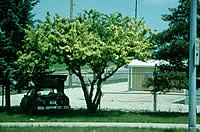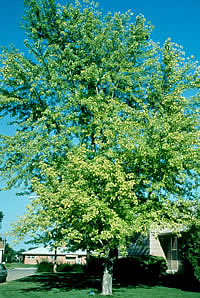What is Iron Chlorosis and What Causes it?
by Michael Kuhns, Extension Forestry Specialist, and Rich Koenig, Extension Soils Specialist
What Is It?
Iron chlorosis is a yellowing of plant leaves caused by iron deficiency that affects many desirable landscape plants in Utah. The primary symptom of iron deficiency is interveinal chlorosis, the development of a yellow leaf with a network of dark green veins. In severe cases, the entire leaf turns yellow or white and the outer edges may scorch and turn brown as the plant cells die. It is common for an individual branch or one half of a tree to be chlorotic while the remainder of the tree appears normal. In some areas vegetation from the entire landscape may be affected, while in others only the most susceptible plants show deficiency symptoms.
Yellow leaves indicate a lack of chlorophyll, the green pigment responsible for photosynthesis (sugar production) in plants. Any reduction in chlorophyll during the growing season can reduce plant growth and vigor. In addition, chlorotic plants often produce smaller fruits of poor quality with bitter flavor. In severe cases, or if iron chlorosis persists over several years, individual limbs or the entire plant may die.

What Causes It?
The causes of iron chlorosis are complex and not entirely understood. Many reactions govern iron availability and make iron chemistry in soil complex. Iron chlorosis frequently occurs in soils that are alkaline (pH greater than 7.0) and that contain lime; conditions that are common in Utah. Even though there typically is plenty of iron in these soils, the high soil pH causes chemical reactions that make the iron solid and unavailable to plant roots. Such iron will be tied up indefinitely unless soil conditions change. This explains why rusty nails or iron shavings do not correct iron deficiency: iron released by these materials immediately forms solids that are unavailable to plants.
Iron deficiency and chlorosis is aggravated by cool soil temperatures and conditions that restrict air movement into soil: plastic sheet mulching, compaction, and water-saturated conditions. Chlorosis is often more severe where topsoil has been removed exposing lime enriched subsoil. Examples are eroded soils or soils subjected to land leveling for new housing developments.
Plants that are native to high pH (alkaline) soils usually don't suffer from iron chlorosis, either because they tend to be very efficient in their use of iron or they can obtain more iron from the soil than non-native or poorly adapted plants. Unfortunately, most of the landscape plants we use here are non-native and many of our landscape trees are native to areas where soil pH is below 6. Such plants grown in high pH soils not only may show iron chlorosis; they may also have chlorosis due to poor availability of other minerals, particularly manganese.

Note: See Preventing and Treating Iron Chlorosis in Trees and Shrubs for information on chlorosis treatment.

